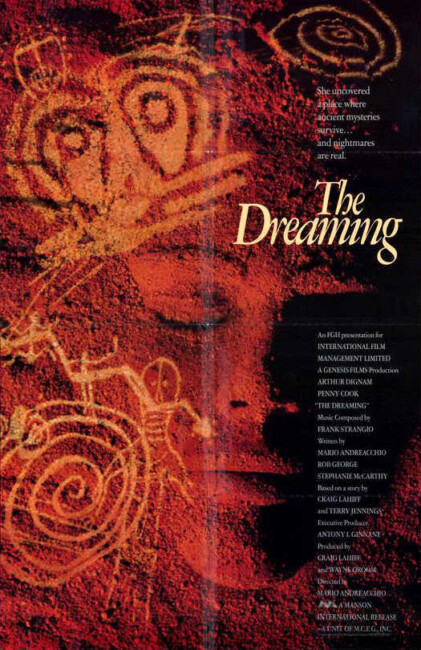Australia. 1988.
Crew
Director – Mario Andreacchio, Screenplay – Mario Andreacchio, Rob George & Stephanie McCarthy, Story – Terry Jennings & Craig Lahiff, Producers – Wayne Groom & Craig Lahiff, Music – Frank Strangio, Production Design – Michael Ralph. Production Company – Genesis Films.
Cast
Penny Cook (Cathy Thornton), Arthur Dignam (Professor Bernard Thornton), Gary Sweet (Geoff Douglas), Kristina Nehm (Warinda), Laurence Clifford (Najira), Patrick Frost (Dr John Graham), John Noble (Dr Eric Richards)
Plot
Professor Bernard Thornton supervises an archaeological dig where they uncover a site where Aborigines were slaughtered by whalers back in the 18th Century. Nine months later, artifacts from the site are placed on display at the university museum. Young Aborigines break in to try and steal them back. An Aborigine girl is apprehended and taken to the hospital badly wounded. Thornton’s daughter Cathy is an ER surgeon and tends the girl but she dies on the operating table. Afterwards, Cathy is haunted by images of the girl and the whalers. The bracelet taken from the museum leaves marks on her wrist. She sets out on a quest to find what happened to the Aborigines.
Peter Weir’s The Last Wave (1977) was an Australian film that was released to arthouses but ventured over into horror territory in its story of a modern man (Richard Chamberlain) being haunted by an Aborigine prophecy of the end of the world. It brought to attention the fascinatingly complex mythology of Australia’s native people The Aborigines. Unfortunately, few Australian films took up the reins offered by this and Aborigine mythology quickly became the stuff of tawdry horror films like Kadaicha (1988) and The Dreaming here.
The Dreaming starts in in some interesting ways that indicate that it is certainly going to be better than Kadaicha was. There are some interesting effects – Penny Cook seeing the Aborigine girl’s skull contorting and moving on the x-ray screen; a scene where Penny is at home and the dead girl appears pressed up against the window. However, this soon dissipates into a series of random novelty deaths – Laurence Clifford running down an alley and being impaled by steel rods fallen from the back of a truck just like Patrick Troughton in The Omen (1976).
The main problem with The Dreaming is that as soon as the cursed bracelet and the past history of the atrocities conducted by the whalers is introduced, the film slows right down. It takes the least interesting path to getting anywhere – it focuses around Penny Cook having to go on a trip in search of clues about the past (it is never much clear what), before she arrives at the town of Innsmouth (a clear H.P. Lovecraft homage).
Certainly, the film seems to quickly lose all interest in any discussion about Aborigine culture. After the introduction of the bracelet, which may be of some cultural importance (we never find out) and the marks left on Penny Cook’s wrist, any interest in the Aborigine artifacts drops off. The flashback scenes to the atrocities of the whalers keep getting replayed but the Aborigines could be replaced by 18th Century villagers or farm girls for all the difference they make. It is telling that despite being focused around Aborigine curses, the viewer learns nothing more about Aborigine culture after watching the film than they knew beforehand.
At times, it feels as though director Mario Andreacchio is determined to copy John Carpenter’s The Fog (1980). There is a very similar plot of unanswered justice from a past slaughter crying out for retribution. Andreacchio even throws in a scene where Gary Sweet passes a ghost ship while rowing that directly copies that ghost galleon scene from The Fog.
There’s a confusing ending where archaeologist Arthur Dignam becomes possessed and chases daughter Penny Cook around a lighthouse – how this relates to the bracelet and atrocities in the past is unclear. Moreover, he is treated as the one who deserves to be punished when in fact he did no more than uncover the dig in the first place. Equally random are the supplemental deaths of Laurence Clifford and Gary Sweet who are only peripherally connected to events. It seems a very random sense of justice being enacted – a problem The Fog also had.
Director Mario Andreacchio had previously made the Australian Backwoods Brutality film Fair Game (1986). Elsewhere, Andreacchio has made a variety of family, dramatic and historical films. His one other venture into genre material was the adventure film The Dragon Pearl (2011).
Trailer here


